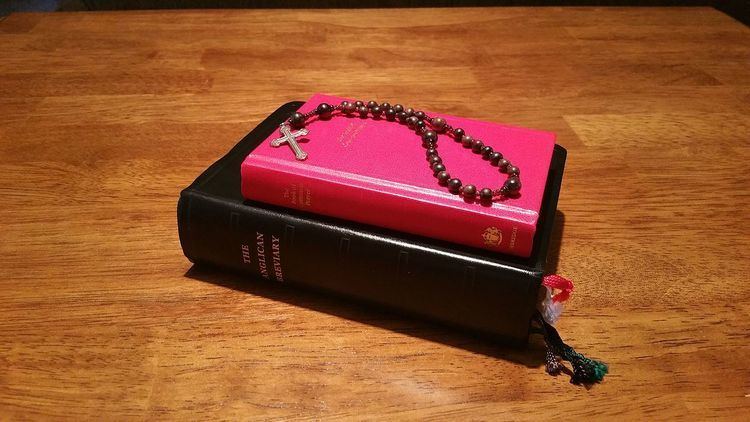 | ||
Anglican prayer beads, also known as the Anglican rosary or Anglican chaplet, are a loop of strung beads used chiefly by Anglicans in the Anglican Communion, as well as by communicants in the Anglican Continuum, and by members of the Anglican Ordinariates within the Roman Catholic Church. Anglican prayer beads were developed in the latter part of the 20th century within the Episcopal Diocese of Texas and this Anglican devotion has spread to other Christian denominations, including Lutherans, Methodists, the Reformed, thus giving rise to the term Christian prayer beads.
Contents
Beads
Anglican prayer bead sets consist of thirty-three beads divided into groups. There are four groups consisting of seven beads with additional separate and larger beads separating the groups. The number thirty-three signifies the number of years that Christ lived on the Earth, while the number seven signifies wholeness or completion in the faith, the days of creation, and the seasons of the Church year.
Groupings
The groupings are called "weeks", in contrast to the Dominican rosary which uses five groups of ten beads called "decades". The beads between are usually larger than the "weeks" beads are called "cruciform" beads. When the loop of beads is opened into a circular shape, these particular beads form the points of a cross within the circle of the set, hence the term "cruciform". Next after the cross on Anglican prayer bead sets is a single bead termed the "invitatory" bead, giving the total of thirty-three. The beads used are made of a variety of materials, such as precious stones, wood, coloured glass, or even dried and painted seeds.
Anglican prayer bead sets are made with a variety of crosses or, occasionally, crucifixes. The Celtic cross and the San Damiano cross are two which are often used.
Prayer
Unlike the Dominican rosary used by Roman and Anglo Catholics, which focuses on the germane events in the life of Christ and asks the Virgin Mary to pray for their intentions, Anglican prayer beads are most often used as a tactile aid to prayer and as a counting device. The standard Anglican set consists of the following pattern, starting with the cross, followed by the Invitatory Bead, and subsequently, the first Cruciform bead, moving to the right, through the first set of seven beads to the next Cruciform bead, continuing around the circle. He or she may conclude by saying the Lord's Prayer on the invitatory bead and/or a final prayer on the cross as in the examples below. The entire circle may be done thrice, which signifies the Holy Trinity.
The Cross
In the Name of God, Father, Son, and Holy Spirit. Amen.
The Invitatory
O God make speed to save me (us),
O Lord make haste to help me (us),
Glory to the Father, and to the Son, and to the Holy Spirit: As it was in the beginning, is now, and will be forever. Amen.
The Cruciforms
Holy God,
Holy and Mighty,
Holy Immortal One,
Have mercy upon me (us).
The Weeks
Lord Jesus Christ, Son of God,
Have mercy on me, a sinner.
The Lord's Prayer
Our Father, who art in heaven,
hallowed be thy Name,
thy kingdom come, thy will be done,
on earth as it is in heaven.
Give us this day our daily bread.
And forgive us our trespasses,
as we forgive those who trespass against us.
And lead us not into temptation,
but deliver us from evil.
For thine is the kingdom,
and the power, and the glory,
for ever and ever. Amen.
The Cross
I bless the Lord.
(Let us bless the Lord
Thanks be to God.)
